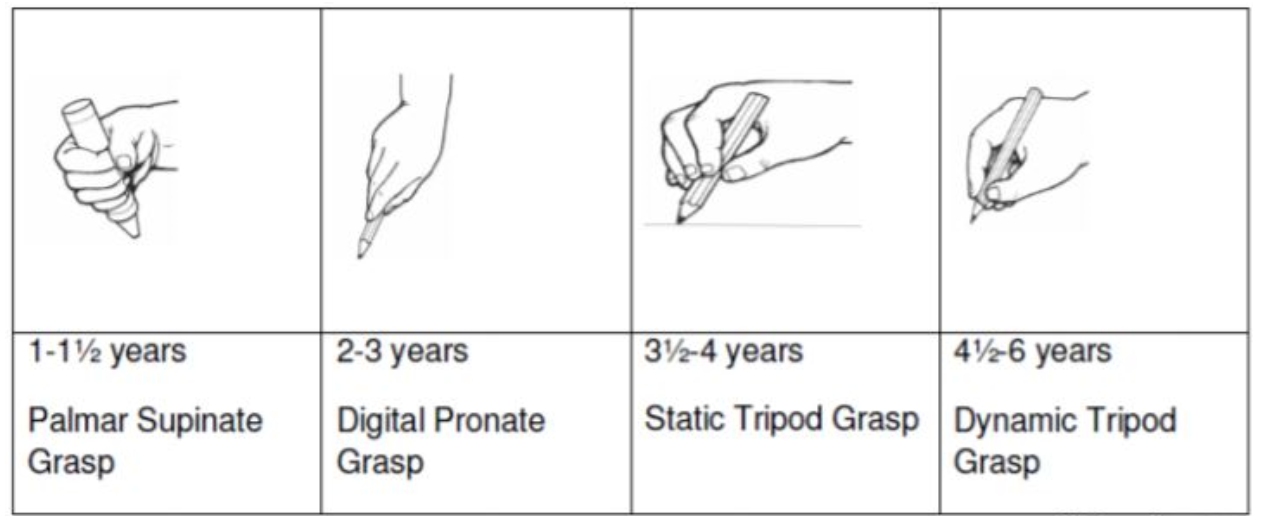When using the Letter Leaders handwriting skills workbook series, there are a variety of factors that influence how your young learners adopt fluid handwriting skills. Below are a series of suggestions based on my decades of experience teaching handwriting to pre-k and early learners.
Best Seated Posture for Handwriting
Seated posture is the student’s position while engaged in an activity seated at the table. An upright position with the head and eyes aligned at the midline of the body is the correct seated posture. Poor seated posture may indicate weakness in the core muscles, crossing midline difficulties, and/or vision disparities.
Possible observations that might suggest a problem with letter formation and handwriting in this area are slumped posture, head resting on arm, or head cocked to one side. Encourage children to having a proper upright, seated posture while they practice handwriting skills.
Hand Preference for Young Learners
Hand preference is the hand the child favors or prefers to use to manipulate the writing utensil. Hand dominance is not fully established in many children until five years of age, so it is normal for some children younger than five to use both hands to manipulate their writing utensils. Watch to observe which hand your child prefers to hold their pencil with. You may also observe them preferring this hand for other activities like eating with utensils and holding their toothbrush.
Correct Pencil Grasp for Learning Handwriting
Pencil grasp or grip refers to the way a person holds a writing utensil. A functional pencil grasp is one that allows for efficient finger movements to control the pencil with the wrist and forearm supporting the hand. A mature pencil grasp is a dynamic tripod grasp pictured below.
Possible observations in this area include how the child holds the pencil (fisted grasp, static grasp, dynamic tripod grasp), variable or changing grasp patterns, and grip pressure (how firmly the student holds onto the pencil and/or how firmly the student presses down on the paper).

Above is a chart showing what grips to commonly expect from children in different age groups. Children between 4.5 and 6 years of age should have moved through each of these developmental grip stages and should be capable of the Dynamic Tripod Grasp with a writing utensil.
Mind the Helper Hand
The helper hand, or nondominant/nonpreferred hand, plays an important role in handwriting as it supports the paper during writing activities. It is important that the helper hand is actively engaged in supporting the preferred hand by holding the paper steady.
Possible observations in this area include no assistance from helper hand, head propped up on helper hand, or helper hand actively assisting in screening by holding the paper steady.
Fine-Motor Skills and Coordination
Fine-motor skills are coordinated movements of the small muscles of the hand, fingers, and wrist. Examples of fine-motor skills include holding a pencil or other writing tool, manipulating school tools like scissors or glue sticks, manipulating small objects for refined activities like beading, and manipulating clothing fasteners like buttons, snaps, and zippers. These skills develop over time and with practice.
Building Hand Strength
The muscles of the hand, fingers, and wrist must be strong enough to engage in fine-motor activities for an age-appropriate amount of time without fatigue. The wrist must provide a stable base to support fine-motor skills, pencil grasp, and proper manipulation of writing utensils and other school tools. Adequate strength is required in the muscles of the fingers to avoid fatigue during pencil-paper activities. Having children play with crayons and musical instruments will help build hand strength and the dexterity of these muscles.
Focused Attention During Handwriting Practice Time
Focused attention is the ability to attend to a given task while filtering out non-relevant stimuli for an age-appropriate amount of time. Typically, focused attention is equal to the age of the child. So a four-year-old child should be able to maintain focused attention to a given activity for approximately four minutes. After this time, children may struggle to continue to focus on the activity at hand and/or may have difficulty filtering out non-relevant stimuli.
Teach Handwriting Skills with Letter Leaders Handwriting Workbook Series in just a few minutes a day.


Recent Comments